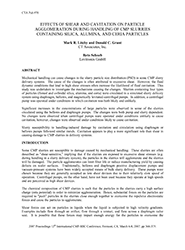

Mechanical handling can cause changes in the slurry particle size distribution (PSD) in some CMP slurry delivery systems. The cause of the changes is often attributed to excessive shear. However, the fluid dynamic conditions that lead to high shear stresses often increase the likelihood of fluid cavitation. This study was undertaken to investigate the mechanisms causing the changes. Slurries containing four types of particles (fumed and colloidal silica, alumina, and ceria) were circulated in a simulated slurry delivery system using diaphragm, bellows, and magnetically levitated centrifugal pumps. In addition, a centrifugal pump was operated under conditions in which cavitation was both likely and unlikely.
Significant increases in the concentrations of large particles were observed in some of the slurries circulated using the bellows and diaphragm pumps. The changes were both pump and slurry dependent. No changes were observed when centrifugal pumps were operated under conditions unlikely to cause cavitation; however, changes were observed under conditions likely to cause cavitation.
Slurry susceptibility to handling-induced damage by cavitation and circulation using diaphragm or bellows pumps followed similar trends. Cavitation appears to play a more significant role than shear in causing damage to CMP slurries in delivery systems.
